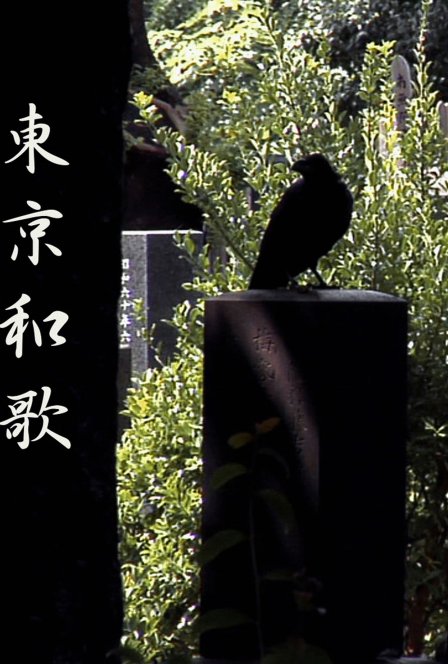Criticism Tanka: A Review Poem
Tokyo Waka:
A City Poem has a
redundant title.
Tokyo is a city;
Waka is a poem-form.
(Imagine calling
a film New York Sonnet: A
City Poem. Too
silly, especially if
the film were “about” pigeons.)
This film depicts the
city’s community of
crows, but it reveals
even more about human
virtues, human prejudice.
A Buddhist monk tears
up while telling a story
about a goldfish
who lived in a lily pot,
eaten by a crow one day.
The crow ate the fish
to survive. A zoo worker
declines to kill snakes
he finds, because, like crows, “they
are just trying to survive.”
He admits many
of the animals living
in the zoo “display
emotional disorders
from the stress of zoo life.”
The monk says, “The crow
has an outside perspective,
and sees right through our
beauty and our ugliness.”
They live well in our home-cell.
The film occupies
itself with reflections on
the Japanese as
a people; an error to
watch them more closely than crows.
Crows place nuts in front
of cars in hopes of cracking
them. They weave their nests
with the care of artisans.
Chim↑Pom coins “hanger artists.”
Chim↑Pom killed rats in
the name of art, not in the
name of survival.
Survival has no name; a
homeless woman has a name.
She says that while she
is homeless, she’s also “home-
full.” This is a crow-
like fullness. If a person
is home-full, we wish them death.
The monk describes our
garbage as “the ruins of
desire.” Crows make
no garbage, but we hate how
they put ours to use again.
A researcher helps
the city attempt to kill
crows by designing
heavy-duty garbage bags
coated with capsaicin.
A municipal
worker catches a frantic
crow inside a trap
and stuff him into a bag.
He tries to, but can’t escape.
The worker describes
gassing crows with CO2
as giving them a
“painless” death. Any death is
an offense against the crow.
The crows have become
harder to catch, however,
over the last ten
years. “They are observing us
in their own way,” notes the monk.
A member of the
Wild Bird Society
tell us that “play is
characteristic of crows.”
They ride sudden gusts of wind.
Crows drop twigs from a
height, then swoop down to catch them
before they drop to
the ground. All dead animals
are ruins of desire.
Chim↑Pom killed a crow
and stuffed it, then held it out
the window of a
moving car. A murder flocked
above, a funeral flock.
Whatever we do
against crows for survival,
we are forgiven.
Whatever we do against
them otherwise, we are not.
This simple truth comes
from an imagined future
in which this group has
no reason to exist; in
which there is no more inside.
Indoor/outdoor crows,
indoor/outdoor solid waste plan,
indoor/outdoor cats,
indoor/outdoor buildings, and
indoor/outdoor home-fullness.
The humans of the
film are articulate; they’re
beautiful. But we
know that about humans, though
we often forget, careless.
Crows, too, speak well and
are beautiful, and the film
knows that, shows us that,
but not in the way I’d wished,
having watched CatCam prior.
German family
moves to South Carolina.
Cat arrives at their
door. Jürgen, the young father,
prohibits his adoption.
He denies his wife
and kids the common pleasure
of feeding a stray,
and then of course he feeds the
cat — named Mr. Lee — himself.
Patriarchal bull-
shit aside, Jürgen comes to
love Mr. Lee, and
worries enough when he leaves
for days to make a camera.
Putting his degree
in electronics to use,
Jürgen engineers
a microchip and builds a
housing hooked to the collar.
Uninhibited,
Mr. Lee goes about his
his life outside the
house and unknowingly takes
photos — lovely photographs.
To see a cat’s-eye
perspective astonishes.
We witness even
more when a videocam
hangs from Mr. Lee’s collar.
The first thing: Mr.
Lee pays attention. He must
participate in
the divine no less than we.
“Prayer consists of attention.”
Mr. Lee has a
rich social life. He has friends;
he has enemies;
he has lovers, surely. What
is he missing? Our own voids.
This film is merely
a good advertisement of
Mr. Lee’s project.
Tokyo Waka would have
been better with a CrowCam.
The New York Times claims
that neither film is more an
animal’s-eye view
than the other, but the New
York Times is quite mistaken.
This is important
to understand, because if
we don’t recognize
an intervention into
our limited sight, we’re lost.
CatCam sees cat life,
whereas Tokyo Waka
sees too fleetingly
human life, city life, and
crow life. We need deep crow life.

